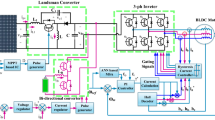Abstract
In this paper, a novel adaptive neuro-fuzzy inference system (ANFIS)-based control technique optimized by Bacterial Foraging Optimization Algorithm for speed control of matrix converter (MC)-fed brushless direct current (BLDC) motor is presented. ANFIS is considered to be one of the most promising technologies for control of electrical drives fed by MC. Optimizing the training parameters of ANFIS, to improve its performance, is still being considered by several researchers recently. Parameters of the online ANFIS controller such as learning rate (η), forgetting factor (λ) and steepest descent momentum constant (α) are optimized by using the proposed algorithm. For the purpose of comparison, proportional integral derivative controller, fuzzy logic controller, PSO-ANFIS and BAT-ANFIS are considered. Set point tracking performances of the proposed system are carried out at various operating points for an industrial BLDC motor operating at a maximum rated speed of 380 rpm and torque of 6.4 N m. Time domain specifications such as rise time, settling time, peak time, steady-state error and peak overshoot in the presence and absence of load torque disturbances are presented. Time integral performance measures such as integral square error, integral absolute error, and integral time multiplied absolute error are analyzed for various operating conditions. Speed fluctuation in the output of BLDC motor is dependent on the source current harmonics of the inverter/converter. To illustrate this, total harmonic distortion (THD) analysis is carried out for the existing PWM inverter and the proposed MC, and it is proved that MC results in reduced THD, as compared to PWM inverter. Simulation results confirm that the proposed controller outperforms the other existing control techniques under various set speed and torque conditions. Statistical analysis is effectively carried out to prove the effectiveness of the proposed controller. Experimental analysis is performed to validate the performance of the proposed control scheme.























Similar content being viewed by others
References
Wang HB, Liu H-P (2009) A novel sensorless control method for brushless DC motor. IET Electr Power Appl 3(3):240–246
Chen J, Tang P-C (1999) A sliding mode current control scheme for PWM brushless DC motor drives. IEEE Trans Power Electron 14(3):541–551
Cui Chenjun, Liu Gang, Wang Kun (2014) A novel drive method for high-speed brushless DC motor operating in a wide range. IEEE Trans Power Electron 30(9):4998–5008
Shao Jianwen (2006) An improved microcontroller-based sensorless brushless DC (BLDC) motor drive for automotive applications. IEEE Trans Ind Appl 42(5):1216–1221
Pawar MA, Sahu NT, Fadnis AY, Ambatkar SY (2014) A novel topology of matrix converter for driving a BLDC motor. Int J Electr Electron Data Commun 2(2):50–53
Devi EJN, Karuvelam PS (2015) Torque ripple minimization of a three phase matrix converter fed BLDC motor. Int J Innov Res Electr Electron Instrum Control Eng 3(2):78–84
Baszynski M, Pirog S (2013) A novel speed measurement method for a high-speed BLDC motor based on the signals from the rotor position sensor. IEEE Trans Ind Inform 10(1):84–91
Pan ZY, Luo FL (2005) Steady state reference current determination technique for brushless DC motor drive system. IEE Proc Electr Power Appl 152(6):1585–1594
Li Z, Xia C (2006) Speed control of brushless DC motor based on CMAC and PID controller. In: The IEEE sixth world congress on intelligent control and automation (WCICA), vol 2, pp 6318–6322
Rubaai A, Ricketts D, Kankam MD (2001) Experimental verification of a hybrid fuzzy control strategy for a high-performance brushless DC drive system. IEEE Trans Ind Appl 37(2):503–512
Premkumar K, Manikandan BV (2014) Adaptive neuro-fuzzy inference system based speed controller for brushless DC motor. Neurocomputing 138:260–270
Rubaai A, Young P (2011) EKF-based PI-/PD-like fuzzy-neural-network controller for brushless drives. IEEE Transa Ind Appl 47(6):2391–2401
Hidayat, Pramonohadi S, Sarjiya, Suharyanto (2013) A comparative study of PID, ANFIS and hybrid PID-ANFIS controllers for speed control of Brushless DC Motor drive. In: International conference on computer, control, informatics and its applications (IC3INA), pp 117–122
Premkumar K, Manikandan BV (2015) Fuzzy PID supervised online ANFIS based speed controller for brushless dc motor. Neurocomputing 157:76–90
Da Silva WG, Acarnley PP, Finch JW (2000) Application of genetic algorithms to the online tuning of electric drive speed controllers. IEEE Trans Ind Electron 47(1):217–219
Qi P (2012) An improved PSO-based optimum design of speed controller for BLDC motor. In: International conference on automatic control and artificial intelligence (ACAI 2012), pp 453–456
Ibrahim HEA, Hassan FN, Shomer AO (2014) Optimal PID control of a brushless DC motor using PSO and BF techniques. Ain Shams Eng J 5(2):391–398
Shi P, Shi G, Lin Y (2008) A nonlinear PI controller of the brushless DC motor based on ant colony system. In: International conference on electrical machines and systems, (ICEMS 2008), pp 4281–4284
El-Wakeel AS, Ellissy AEEKM, Abdel-hamed AM (2015) A hybrid bacterial foraging-particle swarm optimization technique for optimal tuning of proportional-integral-derivative controller of a permanent magnet brushless DC motor. Elect Power Compon Syst 43(3):309–319
Premkumar K, Manikandan BV (2015) GA-PSO optimized online ANFIS based speed controller for Brushless DC motor. J Intell Fuzzy Syst 28(6):2839–2850
Premkumar K, Manikandan BV (2015) Speed control of brushless DC motor using bat algorithm optimized adaptive neuro fuzzy inference sytem. Appl Soft Comput 32:403–419
Palraj SK, Marimuthu R (2014) Control of speed and torque in matrix converter fed BLDC motor using FPGA controller. Int J Power Energy Syst 34(3):99–108
Zwe-Lee G (2004) A particle swarm optimization approach for optimum design of PID controller in AVR system. IEEE Trans Energy Convers 19(2):384–391
Author information
Authors and Affiliations
Corresponding author
Rights and permissions
About this article
Cite this article
Sivarani, T.S., Joseph Jawhar, S., Agees Kumar, C. et al. Novel bacterial foraging-based ANFIS for speed control of matrix converter-fed industrial BLDC motors operated under low speed and high torque. Neural Comput & Applic 29, 1411–1434 (2018). https://doi.org/10.1007/s00521-016-2652-6
Received:
Accepted:
Published:
Issue Date:
DOI: https://doi.org/10.1007/s00521-016-2652-6




